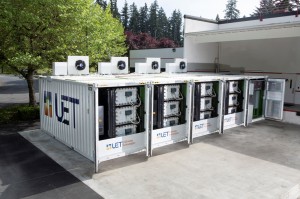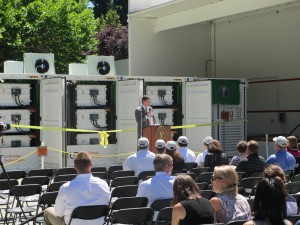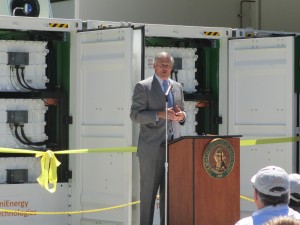Avista Utilities, Snohomish PUD and Puget Sound Energy have been awarded $14.3 million in matching grants from the state’s new Clean Energy Fund to lead energy storage projects with ties to federally funded research at the Department of Energy’s Pacific Northwest National Laboratory.
Gov. Jay Inslee and the state Department of Commerce announced the grants on Tuesday, July 8, at the Mukilteo, WA, facility of UniEnergy Technologies (UET). Snohomish PUD and Avista Utilities will install UET’s all-vanadium redox flow batteries as part of their projects. PNNL developed the battery technology with six years of funding from DOE’s Office of Electricity Delivery and Energy Reliability.
 “We’re using our Clean Energy Fund to position Washington State as a leader in energy storage and work with utilities to develop technologies and strategies that will move the market for renewables forward,” said Gov. Inslee. “Delivering operational value for our utilities is crucial if we’re going to successfully develop and deploy clean energy technologies that save energy and reduce energy costs, reduce carbon emissions, and increase our energy independence.”
“We’re using our Clean Energy Fund to position Washington State as a leader in energy storage and work with utilities to develop technologies and strategies that will move the market for renewables forward,” said Gov. Inslee. “Delivering operational value for our utilities is crucial if we’re going to successfully develop and deploy clean energy technologies that save energy and reduce energy costs, reduce carbon emissions, and increase our energy independence.”
Washington utilities—which already provide some of the cheapest, lowest-carbon electricity in the country—along with private energy developers have added some 3 gigawatts of new wind and solar power over the last 15 years in response to state renewable energy mandates both in the Northwest and California.
In addition to helping the local utilities integrate renewable energy and improve the flexibility, efficiency, and resiliency of an aging electricity grid, these demonstration projects could provide valuable proof to show other utilities—particularly in California—as the market for energy storage grows over the coming decade.
“These emerging markets for new grid technologies are truly global in nature, including grid-scale energy storage, as well as the software, information, and communication technologies that will help emerging economies better optimize the use of energy efficiency and distributed resources,” said Assistant U.S. Energy Secretary Patricia Hoffman, whose office is in charge of electricity delivery and energy reliability.
Gov. Inslee should get credit for helping Northwest utilities and researchers develop smart grid and energy storage expertise, declared Jud Virden, who heads energy and environment programs at Pacific Northwest National Laboratory. Five years ago, as a congressman, he convened a meeting in Seattle ahead of a wave of federal smart grid funding. Inslee said, “We need to win it,” recalled Virden.
The Northwest is now home to the largest smart grid demonstration project in the country. “That also allows us to put new technologies on the grid such as energy storage,” Virden said.
From Molecules to Megawatts
 UET is based in Mukilteo, WA, and is going to market with its vanadium redox flow battery, incorporating refinements to the four-decade-old technology made by the company’s co-founders when they were at the U.S. Department of Energy’s Pacific Northwest National Laboratory. The company has an experienced team, a series of innovations in vanadium electrolyte chemistry and system design, several initial customers, and ambitious plans to scale up production in the next two years.
UET is based in Mukilteo, WA, and is going to market with its vanadium redox flow battery, incorporating refinements to the four-decade-old technology made by the company’s co-founders when they were at the U.S. Department of Energy’s Pacific Northwest National Laboratory. The company has an experienced team, a series of innovations in vanadium electrolyte chemistry and system design, several initial customers, and ambitious plans to scale up production in the next two years.
UET has a potential edge in the large-scale energy storage market expected to blossom over the next five years: One of its main investors, Dalian Bolong Holding Co., Ltd., of China, also happens to own one of the largest suppliers of vanadium and the maker of a central part of the battery hardware.
The origins of UET go back to the early 2000s, when co-founders Liyu Li and Z. Gary Yang had stable, stimulating positions as top research scientists at the DOE laboratory in Richland, WA, working on a range of materials science problems related to energy storage, carbon capture, and other technologies.
In 2009, they started working together on energy storage systems. Li recalls being captivated by the vanadium redox flow battery concept, invented in the mid-1980s. Between 2009 and mid-2012, some $2 million in federal funding went into research at PNNL that would lead to the technology UET is bringing to market. Considerably more money went into the technology from other Department of Energy offices, as well as the broader energy storage problems researchers tackled at the lab.
The flow battery is “just a warm solution that gets circulated through an electrode stack, and that’s where the reactions occur,” said Rick Winter, UET Chief Operating Officer. Current from the electricity grid charges the battery, adding electrons to push the valence states of the vanadium in the electrolyte farther apart, to +2 on one side of the stack and +5 on the other. This creates the electrical potential—stored as chemical energy—to be called upon when the battery discharges back to the grid. When the electrolyte passes again through the electrode stack, electrons go the other way. That creates a current flowing back onto the grid, returning the vanadium’s charge to +3 and +4, ready to be charged up again. As the vanadium passes through its four valence states, it changes to another of its four colors, which are represented in UET’s logo.
Unlike some other battery technologies, the vanadium flow battery can’t catch fire or fail because of a chemical reaction. There is corrosive acid in the electrolyte, but UET makes a point of emphasizing the safety and stability of this chemistry.
“You can charge it completely, you can leave it there, and come back a year later and you’ve got 98 percent of the capacity left in it—if you turn the pumps off. You physically separated your active species [in the two tanks]. So there’s no mechanism for self-discharge,” Winter says.
The company can fit a meaningful amount of energy storage into a standard 20-foot shipping container thanks to the advancements Li, Yang, and their colleagues made at PNNL, which doubled the energy density of the battery. The current design can store about 19.5 watt-hours of energy per liter of electrolyte, a mark UET believes it can improve.
 Three energy storage projects
Three energy storage projects
The winning utilities’ projects and their ties to PNNL and DOE are described below:
• Avista Utilities of Spokane, WA, was awarded $3.2 million. It will use the grant to test how effectively large batteries store energy from wind, solar and other renewable sources. Its project includes installing a UET flow battery in Pullman, WA, to support WSU’s smart campus operations.
The three-year demonstration will occur at a Pullman substation, with a battery-storage system built by UET. The battery system should be able to store enough electricity to power 100 to 120 homes for up to three hours. If the project is successful, Avista could ramp up the number of batteries in use, said Laurine Jue, a company spokeswoman.
Wind turbines and solar panels are intermittent energy sources, producing electricity only when the wind blows and the sun shines. Those kilowatts have to be used immediately, and the inability to store that electricity until customers need it has been one of the drawbacks of renewables for utilities, said Don Kopczynski, Avista’s vice president of energy. “We believe that battery storage could be the missing piece in this puzzle,” he said.
Avista will contribute slightly more than the value of the grant to the battery testing project, Kopczynski said. The battery will arrive in Pullman before the end of the year. After design work and preliminary tests, full-scale testing will begin in about 18 months.
Researchers from Pacific Northwest National Laboratory will collaborate with WSU to develop a control strategy for this project. Avista is participating in the Pacific Northwest Smart Grid Demonstration Project and previously received a DOE Smart Grid Investment Grant.
- Puget Sound Energy of Bellevue, WA, was awarded $3.8 million. Its project includes installing a lithium-ion battery. Puget Sound Energy owns and operates wind projects with a peak capacity of 773 megawatts. It has gone from about two dozen customers with rooftop solar a decade ago to 2,100 today, said utility vice president Andy Wappler.
- As part of a previous project that was jointly funded by the Bonneville Power Administration, Primus Power, Puget Sound Energy and DOE, PNNL analyzed the costs and benefits associated with installing energy storage at various sites within PSE’s service territory.
- Snohomish County Public Utility District No. 1 of Everett, WA, was awarded $7.3 million. Its project will implement a comprehensive program of energy storage and controls integration, including installing a UET flow battery and a lithium-ion battery. This project builds on experience gained and equipment and technologies installed with a DOE Smart Grid Investment Grant.
 The PUD and its principal partner, 1Energy Systems, a Seattle-based company, are building the energy storage systems based on the Modular Energy Storage Architecture (MESA), which provides a standard, non-proprietary and scalable approach to energy storage. The PUD’s energy storage program, which forges partnerships with major U.S. and international business partners, will include two large-scale lithium ion batteries, one built by LG Chem and a second by Mitsubishi-GS Yuasa. Both lithium ion batteries will utilize a Parker Hannifin Power Conversion System. Additionally, the PUD will deploy multiple advanced vanadium flow batteries, which will be built by UET.
The PUD and its principal partner, 1Energy Systems, a Seattle-based company, are building the energy storage systems based on the Modular Energy Storage Architecture (MESA), which provides a standard, non-proprietary and scalable approach to energy storage. The PUD’s energy storage program, which forges partnerships with major U.S. and international business partners, will include two large-scale lithium ion batteries, one built by LG Chem and a second by Mitsubishi-GS Yuasa. Both lithium ion batteries will utilize a Parker Hannifin Power Conversion System. Additionally, the PUD will deploy multiple advanced vanadium flow batteries, which will be built by UET.
Building on these elements, the PUD will deploy an integrated, scalable, optimized control system to manage the energy storage systems (ESS) in an automated fashion. Within each ESS, safe, secure monitoring and control will be provided by the 1Energy Intelligent Controller™ (1E-IC), state-of-the-art software which also securely connects each ESS with utility control, scheduling and optimization platforms. This control system infrastructure is the next critical technology for utilities and the energy storage industry, advancing from merely demonstrating individual energy storage projects to creating an easily deployable, scalable solution that is integrated with other electrical grid assets.
“With this funding, we’re able to significantly ramp up our efforts to develop standardized and scalable energy storage systems,” said Snohomish County PUD CEO Steve Klein. “Working with several public and private partners, it’s our goal to transform the marketplace and make energy storage economically and operationally viable within the energy industry.”
The collaboration will produce state-of-the-art systems, bringing together major equipment and software companies to establish the appropriate industry standards and interfaces. The approach is much different than other energy storage projects in the past and is expected to result in the expanded application of plug-and-play type energy storage systems to help solve the expanding needs of today’s electric grid, which depends more on intermittent resources such as wind and solar.
Since wind and solar power generation is irregular, and not always available during peak energy demand hours, energy storage can make clean energy available wherever and whenever it is needed. While clean energy generation costs continue to decline, energy storage is the critical element needed to foster renewable energy growth.
MESA Project Goals
Key goals of the MESA project include:
- Developing standard electrical and communication interfaces to connect batteries, power converters and software components into modular energy storage systems
- Helping to foster a robust industry ecosystem of modular energy storage component suppliers. By sharing their learning with other electric utilities and technology suppliers, MESA Project partners are advancing a new, component-based approach to energy storage that gives electric utilities more choice, and enables battery, power converter and software manufacturers to reach more customers while focusing on their core competencies.
- For more information on the MESA Alliance, see www.mesastandards.org
Project Partners
- 1Energy Systems, principal partner and architect of MESA and the 1Energy Intelligent Controller (1E-IC) to manage the energy storage systems in an automated fashion
- Alstom Grid, supplier of the PUD’s EMS, SCADA & DMS platforms
- LG Chem, supplier of lithium ion battery
- Mitsubishi-GS Yuasa, supplier of lithium ion battery
- UniEnergy Technologies, supplier of vanadium flow battery
- Parker Hannifin, provider of the MESA-compliant power conversion system
- University of Washington, research expertise in power systems and computer science
- Pacific Northwest National Laboratory, research expertise in power systems
 National expertise for the Northwest
National expertise for the Northwest
To support these projects, PNNL has worked with the state, utilities, technology companies and university researchers to develop detailed descriptions of the various ways energy storage can increase renewable energy use and improve grid efficiency and resiliency. The utilities will consult these descriptions, called use cases, as they implement and evaluate their individual projects.
PNNL is also expected to provide analytical and technical support for the projects. PNNL will conduct benefits analysis, compile field data needed for use cases that help utilities and regulators understand the long-term benefits of new technologies, design plans for acceptance testing and strengthen control strategies. In addition, PNNL plans to collaborate with Washington State University to develop a battery control system for one project and intends to work with the University of Washington’s Clean Energy Institute to share benefits experienced during the projects.
Building on federal research
Results from these Washington state-based demonstrations are expected to contribute to national energy storage efforts. Today’s announcement builds on federal investments in Pacific Northwest grid modernization initiatives, including the Pacific Northwest Smart Grid Demonstration Project, the nation’s largest regional smart grid demonstration project, and Smart Grid Investment Grant funding.
“The Energy Department’s smart grid technology investments and deployment efforts are helping to build a more resilient electric grid that helps communities adapt to increased severe weather events and to enable the integration of distributed and renewable energy resources that mitigate environmental emissions,” said Patricia Hoffman, assistant secretary for DOE’s Office of Electricity Delivery and Energy Reliability. “Today’s announcement is another important step in enabling industry and our National Laboratories to continue working together to improve the resiliency, efficiency, and security of the nation’s grid.”